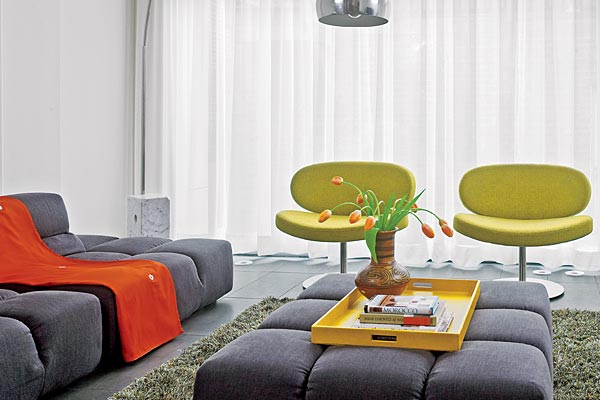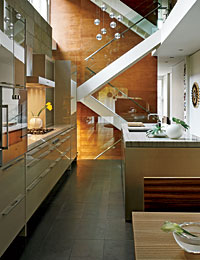
The family room has floor-to-ceiling windows facing floor-to-ceiling shelves; the prefab fireplace is set in a rectilinear structure of raw steel. The furnishings—a low-slung B&B Italia sofa and ottoman, two yellow Cappellini accent chairs, and a classic Arco floor lamp—are sleek and spare, but kid-friendly. Photo Gallery »
Next time you hear someone say it’s impossible to get natural light into a house on a long, narrow Chicago lot, tell them to talk to architect Sig Froelich of Froelich Kim. Using what he calls “clearly defined elements that look like they have been snapped together to create a house,” he converted a dark, plain, 1970s duplex townhouse into a head-turning modern single-family home that’s anything but dark or plain.

An atrium-like kitchen has a double-high ceiling and lavish natural light. The white staircase forms a dramatic zigzag against the stained-maple wall; glass-panel guardrails allow natural light to pass through. The bridge above the kitchen island connects the front of the house to the back on the second floor and also keeps the two busiest levels connected. “A kid could easily yell down, ‘Where’s my grilled cheese?’ from up there,” Froelich says. Photo Gallery »
Froelich was the first (and last) architect the homeowners interviewed a few years ago when they realized that what they had thought would be a merger of two townhomes (theirs and the one behind it) would actually be a teardown and new-construction project.
When they opened Froelich’s portfolio, they were surprised to discover his firm had designed Saltaus, a now-closed Randolph Street restaurant where they had dined that very week, and had marveled at the interior architecture. “It was very minimal, but had a lot of wood in it, and Sig suggested that we do the same in our house,” says the wife.
The first order of business, though, was light. “We wanted the front and the back of the house to be mostly glass and to have as much glass right at the center—where the kitchen is—as possible,” says Froelich. The kitchen has a towering double-high ceiling, with eight-foot-high clerestory windows above the cabinet wall: Light pours in through them, and also through 21-foot-high windows in the nearby stairwell. The result is an ultramodern light well, and with a magnificent chandelier by Bocci dangling over the center island, what would otherwise be a small, dark space feels like a mini-atrium.
As for the wood, it manifests itself in several of Froelich’s signature “elements.” The entire second floor is made up of a single volume wrapped in maple veneer on the inside of the house and a matching, weatherproof material on the exterior. Since this volume is continuous and juts out on both ends of the house in bays, it actually does look “snapped in.” A freestanding, maple-sheathed closet in the foyer has a similar snapped-in quality, and also serves dual functions.
“It affords some privacy,” says Froelich. “But also: You take off coats, go upstairs, and the place is sort of revealed to you.” Revealed, indeed. Like a work of art.
Details
1. In the master bath, smooth gray stone tiles create a muted backdrop on the floor and on all walls but one: Striking green glass tiles, set horizontally, cover the wall behind the tub (a glass shower stands adjacent to it). 2. A quartzite-topped island marks the area of the house where the ceiling starts to soar to double-height. The kitchen is as minimal as can be, with almost no contrasting colors, only contrasting textures: stainless steel appliances, gray lacquer cabinets, off-white quartzite backsplash and countertop (the same material was used on the fireplace in the living room), and gray natural stone tiles above the cabinet line. 3. The living room is like a small lounge, with a low, compact B&B Italia sectional in one corner facing two very low chairs (not visible here), all on a soft round shag rug in front of a prefab fireplace spiffed up with a quartzite-covered structure. Behind the sofa is a freestanding maple-paneled coat closet. Also visible is the elegant Artemide chandelier in the foyer. A custom-made zebrawood table and benches define one edge of the kitchen area; a shaded light fixture over the table marks this communal space as the center of the home. 4. The master bedroom is a cozy space with a tweed-upholstered headboard and a chair covered with wool fabric in a houndstooth weave, both from Jayson Home & Garden. A lowered wood ceiling over the bed makes the sleeping area feel intimate; floor-to-ceiling windows overlook the deck outside. The edgy fabric-swathed light fixture by Bruno Munari is a reminder that this traditionally furnished room is part of a very modern house.
For Resources, see Buy Guide.
Photography: Nathan Kirkman
Styling: Diane Ewing
Related:



